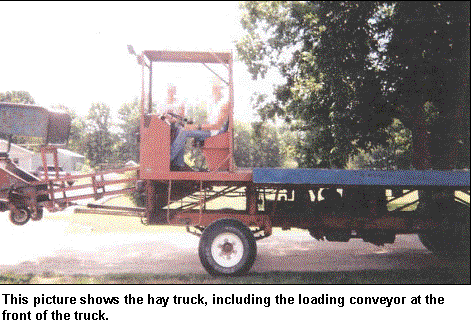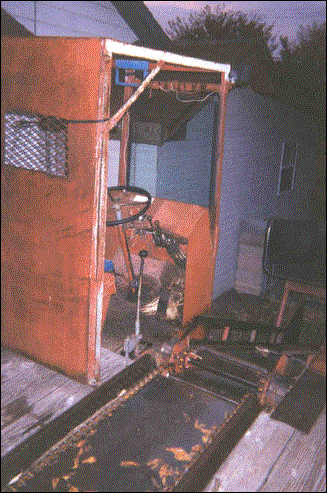A 17-year Old on a Hay Hauling Crew Died from Injuries Received When He Fell from a Moving Hay Truck and was Apparently Run Over by the Vehicle’s Tire in Oklahoma

SUMMARY
A 17-year old on a hay hauling crew died on July 8, 2000 from injuries received when he fell from a moving hay truck and was apparently run over by the vehicle’s tire. OKFACE investigators concluded that to prevent similar occurrences, employers should:
- Ensure that vehicles are adequately equipped with seating and safety belts for all passengers.
- Ensure that sideboards or rails are installed on all open-sided vehicles on which employees must ride during vehicle operation.
- Ensure that all employees are aware of the hazards to which they will be exposed and the controls necessary to prevent injury.
INTRODUCTION
A 17-year old youth on a hay hauling crew died on July 8, 2000 from injuries received when he fell from a moving hay truck on which he was riding and was apparently run over by the vehicle’s tire. The deceased was working on a three-person crew hauling square hay bales from a field to a storage barn approximately three to four miles away. All three crew members, including the employer, were 17 years old. The victim had worked for the employer during the previous summer season. OKFACE investigators reviewed the death certificate, the medical examiner’s report, the state highway patrol traffic collision report, and a newspaper clipping on the incident. While conducting the site survey, the investigators interviewed the father of the victim, the employer and his parents, the third crew member and his parents, and the owner of the hay truck. FACE investigators also interviewed state and federal child labor law enforcement officials.
The employer had managed a seasonal hay hauling business for two years, hiring three or four friends at any one time to stack the hay; the employer drove the truck. The number of persons hired to work was determined by the amount of hay to be hauled.

The hay truck was a 1969 model built by United Manufacturers, Inc. that was manufactured specifically for hauling hay. It was designed for both field and road use. The hay truck was approximately 25 feet long by 8½ feet wide. It was equipped with a loading conveyor in the front of the vehicle and another conveyor that transported the hay down the center of the vehicle toward a rear guard that prevented it from falling off the back of the truck. As the hay moved down the conveyor, the workers removed the bales from the conveyor and stacked them from the back of the vehicle forward until the truck was loaded. Fully loaded, the vehicle carried 150 square hay bales, typically weighing approximately 65 pounds each, that were stacked in five tiers and 13 rows (front to back of the vehicle). The vehicle was equipped with a driver’s seat. In addition, an area enclosing a large water jug on the front right side of the truck bed was typically used as a passenger’s seat. The vehicle was not equipped with safety belts. The employer leased the hay truck from a friend of the family. The vehicle owner, who had purchased the truck in 1979, did not have an owner’s manual. He had modified the truck to add an enclosure to the driver’s seat and control panel.
Although the three crew members had participated in safety training at their high school through the vocational agriculture and industrial education curriculum, the employer did not have a formal safety program and had not developed or provided safety training for his employees. The vehicle owner had not provided safety training regarding vehicle operation to the youth employer.
INVESTIGATION
 |
 |
The temperature at the time of the incident was approximately 80°F, and the wind was southerly with an average speed less than 5 mph. The humidity was high with a dew point of approximately 72°F. The crew reported for work at 3:00 p.m. on the afternoon of July 7, 2000, expecting to work until the field in which they were to work was cleared of approximately 700 bales of hay. The employer drove the truck, and the victim and the other crew member stacked the hay as it was loaded. All three youths were considered to be in excellent physical condition.
The crew had removed all the hay from the field and was transporting the last load with 30 bales to the barn at approximately 1:15 a.m. The victim was sitting on a hay bale behind the driver’s seat, which was occupied by the employer. The other crew member was sitting on the water jug and was facing the driver. The driver was proceeding eastbound on a paved road with a good surface condition at a speed of approximately 25 mph. As the vehicle began to negotiate a curve, the crew member on the water jug noticed that the victim stood up, presumably to relocate. The crew member on the water jug then returned his attention to the driver and they resumed their conversation. The driver noted a “bump,” after which both youths looked and realized that the victim was no longer on the truck. The driver stopped the vehicle immediately and both youths went back to find the victim whose body was located approximately ten feet southeast of the point of impact (approximately two feet north of the edge of the roadway). The truck had apparently rolled over the victim’s head.
The young men left the scene to get help and an ambulance and highway patrol trooper responded. The victim was pronounced dead at the scene, and the body was transported to the morgue for investigation by the medical examiner. Toxicology reports for alcohol on the victim were negative.
CAUSE OF DEATH
The Medical Examiner listed the immediate cause of death as blunt trauma of the head.
RECOMMENDATIONS
Recommendation #1: Employers should ensure that vehicles are adequately equipped with seating and safety belts for all passengers.
Discussion: Although not specifically enforceable in this case, OSHA regulations in Parts 1910.266, 1917.43, and 1926.601 establish requirements for safe seating and seat belts in motor vehicles. These safety design principles could appropriately be extrapolated to this particular equipment and operation when the vehicle is operated on a roadway. The decreased speed of the truck during fieldwork reduces the risk of a fall; however, the risk increases with speed on improved roadways and therefore requires hazard controls to prevent injury.
Recommendation #2: Employers should ensure that sideboards or rails are installed on all open-sided vehicles on which employees must ride during vehicle operation.
Discussion: The vehicle involved in this incident had a front-loading conveyor and a rear gate; however, all other sides of the vehicle were open. The use of sideboards or rails, while possibly placing some constraints on the loading of the vehicle, may have prevented the fall that resulted in the victim’s fatal injuries.
Recommendation #3: Employers should ensure that all employees are aware of the hazards to which they will be exposed and the controls necessary to prevent injury.
Discussion: The fact that the victim moved into a position that exposed him to the hazard of falling from the moving vehicle indicates a lack of appreciation for the hazard and risk of such an action. Awareness of the hazard and risk is critical for avoidance of actions that may expose workers to injury. The development of policies and work practices, preferably in writing for those operations, jobs, and tasks that present the greatest hazard and risk, is a necessary step for employee conformance with established hazard controls. Once developed, the policies and practices must be adequately communicated to affected employees and reinforced as necessary to ensure conformance with critical hazard controls.
Safety professionals, educators, and youth entrepreneurial organizations should partner to develop a safety support network for entrepreneurial youth to provide information that is necessary for the successful management of safety and health risks by young business owners. Young entrepreneurs play an important societal role; however, they typically lack the experience to manage certain aspects of the business, including occupational safety and health. Those individuals and organizations that are best positioned to provide the necessary technical expertise and those institutions that are best positioned to educate young entrepreneurs in the safe and healthful management of their business should partner to create a network to provide needed assistance to young business owners. Local safety councils and professional safety organizations, for instance, can provide the needed expertise and mentoring for interested individuals who are made aware of those training opportunities through their school or through organizations like the Future Business Leaders of America or Future Farmers of America.
REFERENCES
- 29 CFR 1910.178, Powered industrial trucks (General industry).
- 29 CFR 1910.266, Logging operations (Special industry).
- 29 CFR 1917.43, Powered industrial trucks (Maritime operations).
- 29 CFR 1926.601, Motor vehicles (Construction).
- Oklahoma Statutes, Title 40, Section 71-89
The Oklahoma Fatality Assessment and Control Evaluation (OKFACE) is an occupational fatality surveillance project to determine the epidemiology of all fatal work-related injuries and identify and recommend prevention strategies. FACE is a research program of the National Institute for Occupational Safety and Health (NIOSH), Division of Safety Research.
These fatality investigations serve to prevent fatal work-related injuries in the future by studying the work environment, the worker, the task the worker was performing, the tools the worker was using, the energy exchange resulting in injury, and the role of management in controlling how these factors interact.
To contact Oklahoma State FACE program personnel regarding State-based FACE reports, please use information listed on the Contact Sheet on the NIOSH FACE web site Please contact In-house FACE program personnel regarding In-house FACE reports and to gain assistance when State-FACE program personnel cannot be reached.
Back to NIOSH FACE Web
